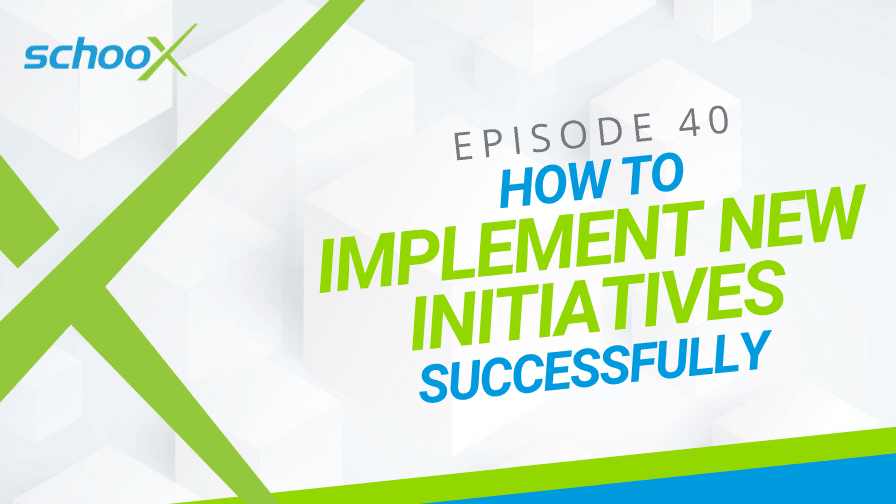26 July 2021
8 Min Read

Whether it’s to keep up with changing technology, a fast-paced market, new regulations, or something else, implementing a new initiative is a necessary part of running a successful business.
However, it can be a tricky process. One simple change can affect every single part of an organization.
If a new initiative is to be introduced in your organization, you need to be prepared. Most organizations focus on project management, process management, or some kind of implementation methodology. However, this overlooks one key area – the people affected by the changes.
In this episode of The Learning Xchange, Matthew Brown (Schoox’s VP of Learning and Brand Success) explores the steps organizations need to take to implement change effectively.
Listen to the podcast below or keep reading.
Why learning and development is key to implementing initiatives
The key to implementing a successful new initiative is to have everyone on the same page, aware of the changes, and eager to get involved. That’s where L&D professionals come in. Who else is better placed to understand people and how to drive engagement?
L&D professionals are uniquely equipped to see all areas of an organization and provide support where needed.
How to manage requirements across the organization
One way to start is to get it all down on paper and document the requirements of everyone. What does everyone need for this new implementation to be successful?
Start with the global requirements of the organization. What’s going to apply to anyone and everyone affected by this implementation?
Next, use a department or team-specific approach. Some things will only apply to a small subset of the organization.
You may walk away with multiple lists, but this can help you better understand how changes will affect everyone.
Triage the requirements
Once we have all this documented, the next move is to triage the requirements. This is where you work out which requirements are critical versus which are just nice to have.
When we designate something as critical, it’s vital to document and discuss everything thoroughly. The more specific these conversations are, the better.
Once you get a better understanding of what’s critical, you can reprioritize things and streamline the run-up to the big launch of your company’s initiative.
Engaging people in the initiative
The next stage is all about the people. How do you engage the people in your organization? Who do you need to be engaged in this project?
This is something a lot of places overlook. It’s easy for us to get locked into just identifying the active, core project team – the people who will be directly involved in executing the changes.
While these team members are key, you also need other perspectives.
You need your key decision-makers, those who will help make new decisions and keep the project oriented to its goals. You also need your stakeholders, those who have a stake in the project, either from contributing feedback or other input.
Also, think about those who don’t have process ownership but may be affected by these changes. You can split them up into three different groups:
1. The champions
These are the people in your organization who are advocates of the team or the new changes coming. They’re on board with the coming changes, have enthusiasm, and are willing to support others.
2. The anti-champions
These are the types of employees who have more of a “sit and wait” mindset. They may even openly challenge the ideas and are naturally skeptical.
It’s important to have both representations from champions and anti-champions to get a true slice of your employees’ mindsets.
3. The influencers
Look at where the influence is coming from in the organization and strategically bring these individuals into the fold of the project. These may or may not be reflected in your champions or anti-champion groups, but it’s important to get balanced perspectives.
If you only have champions in your influencer group, the initiative is undermined from the beginning. People will be suspicious of a project that people have only nice things to say about.
You may want to avoid any negativity, but be brave and get those visible anti-champions on the project as well. You may be able to convert them to advocates by the end of the project.
Get feedback
Once you have all the requirements written down, you can circulate them through the entire group to get feedback. The earlier you do this, and the larger the group, the more time you save in the long run.
By getting feedback early on, you’re identifying barriers and obstacles sooner before they negatively impact the project.
Be realistic about the launch of your initiative
The next tip is to be realistic. Sometimes we can all be guilty of delaying a launch because we want it absolutely perfect. The problem is that these delays can mean you miss out on the ideal timing when there’s engagement and momentum.
Instead, you could prioritize and deploy the changes that matter most in phase one. This shows that you are taking action, driving change, and are solving problems. It doesn’t matter if it’s not the whole thing yet, but it gets the ball rolling.
Communicate often
When making any major changes that affect the whole organization, communication is the secret ingredient to success.
Don’t be afraid to communicate often and throughout the entire project. Poor communication can cause even the best implementations to fail.
Even if your team is working hard, you’re hitting all the goals and milestones, you can still trip up if communication isn’t clear.
Introducing a new system or process is a big change, and everyone reacts to change differently. Finishing up your project, launching it, and expecting everyone to get on board straight away is just not realistic.
Instead, you should communicate throughout the build-up to the launch and afterward as well. Everyone will know what to expect then.
You can start communicating openly about this in a few ways.
1. Sow the seeds
One way is to introduce it when you start documenting requirements. You can start to sow the seeds here and build excitement, even if you don’t explain the full scope of the project just yet.
2. Use cascading messages
Make sure you also check in with your leaders at regular intervals. Get them involved from the start and let them see what’s changing. This will help them to better understand the changes, and they can start to instill confidence in the employees.
3. Use direct messaging to all employees
As well as going directly to the leaders, we should also go directly to the employees. Some company cultures make this harder but going to the teams that will be driving the process makes the project much more inclusive.
If you just rely on cascading messages, it can create the wrong impression and perpetuates a strict hierarchy of who gets the exclusive information.
4. Connect feedback to action
The final piece of communication advice is to connect feedback to action. Whenever we receive feedback, we should always approach it with the intention that we will act on it.
Everyone wants to be seen and heard, so when employees give feedback, they need to know that it’s contributing to real action. It shows you’re truly valuing your employees and their opinions, which is one of the quickest ways to build trust and confidence.
Remember to celebrate the success of implementing your initiative!
Finally, it’s also important to remember to celebrate. Sometimes we can be too focused on the work, the processes, and hitting all the timelines and budgets involved with the initiative that we lose sight of the celebration stage.
Celebrating is a clear signal of progress. It’s a way to create a positive connection across the organization and to just have fun. This is where you just let loose with all your thoughts and celebrate the milestones your team has reached.
If we can celebrate all of that, it creates an expectation for people. It shows that we should never stop learning. We should never stop growing and evolving.
RELATED RESOURCES



